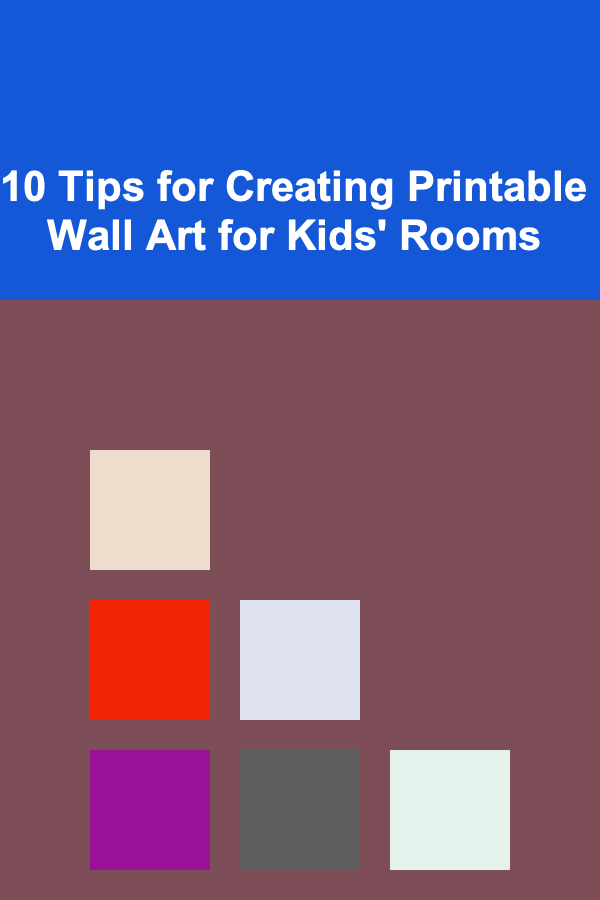
10 Tips for Creating Printable Wall Art for Kids' Rooms
ebook include PDF & Audio bundle (Micro Guide)
$12.99$5.99
Limited Time Offer! Order within the next:

When designing a child's room, one of the most impactful elements is the artwork. The right wall art can transform a room, making it feel more inviting, creative, and tailored to the child's personality. However, finding the perfect art pieces for kids' rooms can often be expensive or difficult to match with the overall room decor. That's where printable wall art comes in---a budget-friendly, customizable solution that allows you to create personalized designs in the comfort of your own home. Whether you're decorating a nursery, a playroom, or a kid's bedroom, these 10 tips will guide you in creating printable wall art that both children and parents will love.
Choose Age-Appropriate Themes
The first step in creating printable wall art for kids' rooms is choosing a theme that suits the child's age. Younger children might enjoy whimsical, colorful designs, such as animals, nature, or simple geometric shapes, while older kids might prefer more sophisticated themes like sports, music, or inspirational quotes. Here are a few theme ideas based on age:
- Infants and Toddlers: Soft pastel colors, animals, alphabets, numbers, or abstract shapes.
- Preschoolers and Early Elementary: Fun, playful designs like dinosaurs, outer space, underwater adventures, or fairy tales.
- Tweens and Teens: Minimalist art, motivational quotes, nature photography, or designs based on personal interests like hobbies or favorite pop culture references.
By selecting the right theme for their age, you'll ensure that the art continues to feel relevant as they grow and evolve.
Incorporate Bold and Bright Colors
Children are naturally drawn to vibrant, bold colors. Bright hues not only capture their attention but also contribute to an energetic, joyful environment. When designing printable wall art, use colors that are visually stimulating yet harmonious. Keep in mind the overall color palette of the room to ensure the artwork complements the space.
If you're not sure where to start, consider using a color wheel to combine primary colors like red, blue, and yellow with secondary colors like green, orange, and purple. For more neutral rooms, try adding pops of color through abstract art or simple patterns, like stripes or polka dots, in primary or pastel tones.
Personalize with the Child's Name
Personalized artwork is always a hit, especially when it's something that truly belongs to the child. Adding their name to a piece of wall art makes the design more special and meaningful. You can play around with typography by selecting fonts that match the room's theme---whether whimsical, modern, or vintage. For example:
- For a jungle-themed room, you could incorporate the child's name using a leafy, vine-like font.
- For a sports room, you could use fonts that resemble a jersey number or team logo.
- For a space-themed room, you could create a name design that mimics the look of a constellation or galaxy.
Personalization also offers a fantastic opportunity to teach children to recognize and spell their own names, which makes the art both decorative and educational.
Incorporate Educational Elements
While wall art is often about creating a beautiful or fun space, it can also be educational. Printable art is a great way to incorporate learning into your child's room in a subtle, playful way. Here are a few ideas:
- Alphabet Posters: Use fun illustrations of animals, objects, or characters that correspond with each letter of the alphabet. For example, "A for Apple," "B for Balloon," and so on.
- Numbers and Shapes: Create colorful number charts or shape posters, turning learning into an interactive experience.
- Maps: Hang a world map, country map, or even a solar system chart, which will both educate and inspire a sense of curiosity about the world.
Educational wall art not only helps foster early learning but also provides opportunities for discussion and exploration.
Use Minimalist Designs for a Timeless Look
While bold and colorful designs are great for kids' rooms, minimalism can also work wonderfully, especially if you're going for a more sophisticated look. Clean lines, simple shapes, and neutral colors can create a timeless piece that will grow with the child.
Minimalist art may involve geometric patterns, simple animals, or abstract representations of nature, such as mountains or clouds. This style not only looks great in any room but also allows the artwork to blend seamlessly with a variety of other decor styles.
Incorporate Motivational Quotes
Motivational quotes can be powerful tools for boosting a child's confidence and encouraging positive behavior. Whether it's a reminder to be kind, try their best, or stay curious, a positive affirmation can serve as a gentle daily encouragement.
Here are some ideas for motivational quotes to include in kids' room artwork:
- "Dream Big"
- "You are Amazing"
- "Be Brave, Be Bold"
- "The Sky's the Limit"
- "Believe in Yourself"
You can also include the child's favorite quote from a book, movie, or cartoon to make it more personal and special. Pairing these quotes with playful fonts and illustrations adds extra charm.
Create a Gallery Wall of Prints
Instead of focusing on just one piece of artwork, consider creating a gallery wall filled with various printable designs. A gallery wall allows you to showcase a range of artistic styles, themes, and sizes, creating a dynamic and visually interesting focal point in the room.
You can mix and match a variety of art prints---like animals, typography, and abstract art---to tell a cohesive story. The key is to ensure that each print complements the others in terms of color, style, and size. Consider using frames of the same color or theme for consistency and uniformity.
Use Texture for Added Depth
While printable wall art is traditionally flat, you can play around with textures to make the artwork more dynamic. Adding textures, such as using thicker paper or even combining printables with fabric or felt elements, can add an extra layer of visual interest to the design.
For example, you could print a design with a textured background or use materials like felt or cotton to create a 3D element in the art, such as a fuzzy animal or textured clouds. Textured wall art helps bring a sensory dimension to the room, which is especially appealing to younger children.
Consider Seasonal and Holiday Themes
Another fun way to use printable wall art in a kid's room is by rotating the designs according to the season or upcoming holidays. Whether it's Christmas, Halloween, Easter, or a child's birthday, themed artwork can help celebrate special occasions.
For example, you could create Halloween-themed printable wall art with pumpkins, ghosts, and bats, or a winter wonderland design with snowflakes and snowmen. Rotating artwork in this way helps keep the room fresh and exciting and gives the child something to look forward to as the seasons change.
Make It Interactive
Finally, make the printable wall art interactive to encourage creativity and play. There are several ways to do this, such as creating art that can be colored in, providing spaces for the child to add their drawings, or incorporating elements that can be rearranged.
For example:
- Color-Your-Own Prints: Print designs that children can color themselves, such as animals, landscapes, or abstract patterns.
- Magnetic Wall Art: Create pieces with removable parts that the child can move around and play with, like movable shapes or a magnetic animal farm.
- Growth Charts: Include a growth chart where kids can mark their height over time.
Interactive art turns a simple decoration into a fun activity, providing entertainment while also enhancing the child's room.
In conclusion, printable wall art for kids' rooms is a wonderful way to enhance the space while also giving children an environment that nurtures creativity, learning, and imagination. By following these tips, you can create designs that are both beautiful and functional, from educational themes to personalized artwork. With a little creativity and some thoughtful planning, your child's room will be a delightful, inspiring place to grow, dream, and play.
Reading More From Our Other Websites
- [Home Staging 101] How to Use Rugs to Define Spaces in Staging
- [Small Business 101] How to Set Up a Hybrid Physical‑Online Storefront for a Small Business
- [Organization Tip 101] How to Make Your Yard Sale Eco-Friendly
- [Organization Tip 101] How to Prepare a Capsule for Special Life Events
- [Home Staging 101] How to Stage Your Home's Garage for Maximum Appeal
- [Star Gazing Tip 101] Best Star Gazing Locations Near Me: Discovering Local Dark Sky Parks & Observatories
- [Home Cleaning 101] Outdoor Cleaning Tips: How to Clean Your Patio and Deck Like a Pro
- [Home Family Activity 101] How to Build Amazing Creations with LEGOs as a Family
- [Home Lighting 101] How to Choose High CRI Bulbs for Better Color Accuracy in Your Home
- [Paragliding Tip 101] Best Paragliding Gear for Coastal Flying

How to Create a Space-Saving Home Office Without Sacrificing Comfort
Read More
How to Tidy Up Your Entryway for a Welcoming Home
Read More
How to Write a Strong Lease Agreement for Your Rental Property
Read More
How to Pair Wine with Desserts (Beyond Chocolate)
Read More
How to Let ChatGPT Help You Learn Sociology
Read More
How to Find Joy and Satisfaction in Healthy Eating
Read MoreOther Products

How to Create a Space-Saving Home Office Without Sacrificing Comfort
Read More
How to Tidy Up Your Entryway for a Welcoming Home
Read More
How to Write a Strong Lease Agreement for Your Rental Property
Read More
How to Pair Wine with Desserts (Beyond Chocolate)
Read More
How to Let ChatGPT Help You Learn Sociology
Read More